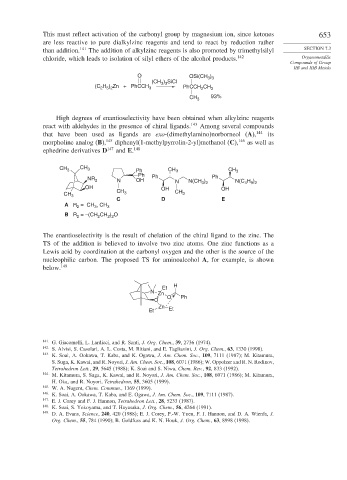Page 678 - Advanced Organic Chemistry Part B - Reactions & Synthesis
P. 678
This must reflect activation of the carbonyl group by magnesium ion, since ketones 653
are less reactive to pure dialkylzinc reagents and tend to react by reduction rather
than addition. 141 The addition of alkylzinc reagents is also promoted by trimethylsilyl SECTION 7.3
chloride, which leads to isolation of silyl ethers of the alcohol products. 142 Organometallic
Compounds of Group
IIB and IIIB Metals
O OSi(CH )
3 3
(CH ) SiCl
3 3
H ) Zn + PhCCH
2
(C 2 5 2 3 PhCCH CH 3
CH 3 93%
High degrees of enantioselectivity have been obtained when alkylzinc reagents
react with aldehydes in the presence of chiral ligands. 143 Among several compounds
that have been used as ligands are exo-(dimethylamino)norborneol (A), 144 its
morpholine analog (B), 145 diphenyl(1-methylpyrrolin-2-yl)methanol (C), 146 as well as
ephedrine derivatives D 147 and E. 148
CH 3 CH 3 Ph CH 3 CH 3
Ph Ph
NR 2 N OH N N(CH 3 2 Ph N(C H )
)
4 9 2
OH OH OH
CH 3 CH 3 CH 3
C D E
= CH , CH
A R 2 3 3
B R = –(CH CH ) O
2 2
2
2
The enantioselectivity is the result of chelation of the chiral ligand to the zinc. The
TS of the addition is believed to involve two zinc atoms. One zinc functions as a
Lewis acid by coordination at the carbonyl oxygen and the other is the source of the
nucleophilic carbon. The proposed TS for aminoalcohol A, for example, is shown
below. 149
H
Et
N Zn
O O Ph
Zn
Et Et
141
G. Giacomelli, L. Lardicci, and R. Santi, J. Org. Chem., 39, 2736 (1974).
142 S. Alvisi, S. Casolari, A. L. Costa, M. Ritiani, and E. Tagliavini, J. Org. Chem., 63, 1330 (1998).
143 K. Soai, A. Ookawa, T. Kaba, and K. Ogawa, J. Am. Chem. Soc., 109, 7111 (1987); M. Kitamura,
S. Suga, K. Kawai, and R. Noyori, J. Am. Chem. Soc., 108, 6071 (1986); W. Oppolzer and R. N. Rodinov,
Tetrahedron Lett., 29, 5645 (1988); K. Soai and S. Niwa, Chem. Rev., 92, 833 (1992).
144
M. Kitamura, S. Suga, K. Kawai, and R. Noyori, J. Am. Chem. Soc., 108, 6071 (1986); M. Kitamura,
H. Oka, and R. Noyori, Tetrahedron, 55, 3605 (1999).
145 W. A. Nugent, Chem. Commun., 1369 (1999).
146 K. Soai, A. Ookawa, T. Kaba, and E. Ogawa, J. Am. Chem. Soc., 109, 7111 (1987).
147
E. J. Corey and F. J. Hannon, Tetrahedron Lett., 28, 5233 (1987).
148 K. Soai, S. Yokoyama, and T. Hayasaka, J. Org. Chem., 56, 4264 (1991).
149
D. A. Evans, Science, 240, 420 (1988); E. J. Corey, P.-W. Yuen, F. J. Hannon, and D. A. Wierda, J.
Org. Chem., 55, 784 (1990); B. Goldfuss and K. N. Houk, J. Org. Chem., 63, 8998 (1998).

